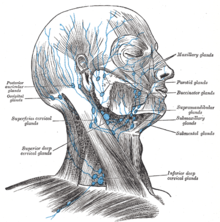Mandibular lymph nodes
The lower jaw lymph nodes (Latin: Nodi lymphoidei submandibulares , also Lymphonodi submandibulares ) are a group of three to six lymph nodes on the lower edge of the body of the lower jaw laterally and superficially to the lower jaw salivary gland . The catchment area (tributary area) of the lymph nodes are the cheek, nose, the nasal corner of the eye, lips, roof of the mouth, jaw and part of the tongue. Lymph drainage occurs through the deep cervical lymph nodes .
In animal anatomy, the lymph nodes are referred to as Lymphonodi [Lnn.] Mandibulares and, comparatively anatomically, assigned to the Lymphocentrum mandibulare . In cattle there is usually only one lymph node on both sides, in pigs and predators two or more, and in horses a large package of many small lymph nodes. In horses, the lymph node packages on both sides merge at the front, creating a V-shaped structure. The tributary area largely corresponds to the conditions in humans. Lymph drainage mostly takes place via the lymphocenter retropharyngeum , in horses directly into the cranial deep cervical lymph nodes.
In cats and pigs, additional mandibular lymph nodes ( Lymphonodi mandibulares accessorii ) occur either directly behind the mandibular lymph nodes (cats) or further away at the confluence of the external jugular vein (pigs).
literature
- U. Gille: Cardiovascular and immune system, Angiologia. In: F.-V. Salomon et al. (Ed.): Anatomy for veterinary medicine. Enke-Verlag, Stuttgart 2004, ISBN 3-8304-1007-7 , pp. 404-463.
